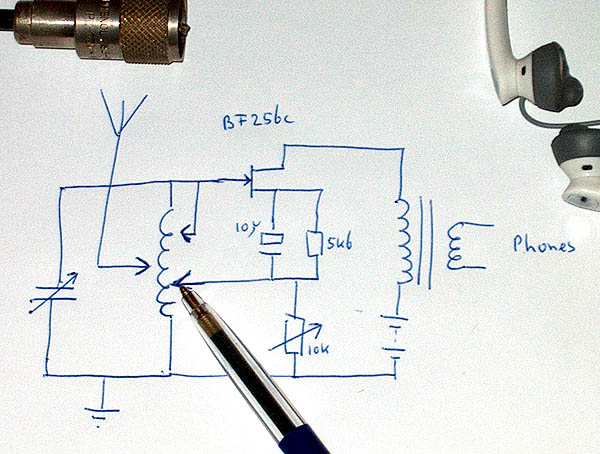
The very simple receiver for the whole shortwave band.
Regenerative control, tuning, band selection, it has everything.
Even a fine tuning by moving your hand towards the coil!
A VERY SIMPLE RECEIVER
KLIK HIER VOOR DE NEDERLANDSE VERSIE

The very simple receiver for the whole shortwave
band.
Regenerative control, tuning, band selection, it has
everything.
Even a fine tuning by moving your hand towards the coil!
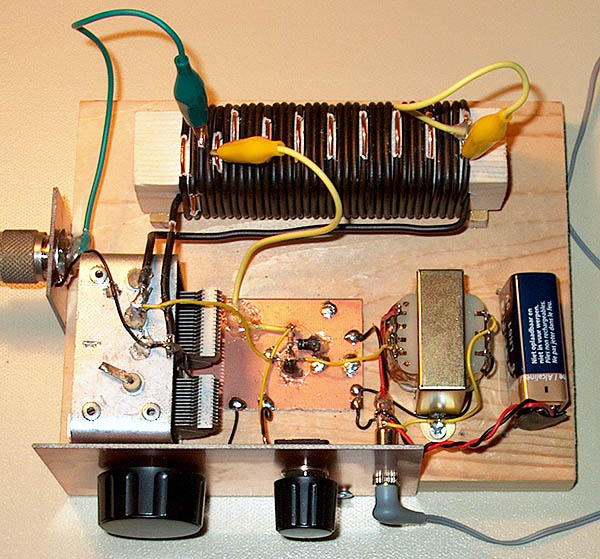
Top view, the coil in use for 80 meter.
Fine tuning by
moving your hand from or towards the coil!
Low battery current!
The battery current is only 0,5 mA. Therefore,
the battery life is one year if you use the receiver 2 hours per day!
Description
The heart of the circuit is the fet BF256c (c type has
the highest gain). By means of the 5600 ohm resistor, it works in the non-
linear part of the Id/Vgs characteristic. Experiment with that value in your
receiver for better performance. The 10uF capacitor is for decoupling of the
resistor, also for high frequencies. Perhaps that you need to add an extra 0.1uF
capacitor in parallel for decoupling of the RF frequencies but I did not hear
any difference. The regeneration is controlled by means of the 10k
potentiometer. Adjust it for maximum sensitivity. The audio transformer is
necessary for impedance matching between the fet and the headphones. The 5000
ohm primary tap was selected here at first, later the 10000 ohm. Of course you
can use also another transformer. Even a 230 volt / 12 volt transformer from and
old mains adapter is often useable, just try it. The headphones used is a
Philips, model HS415. Sensitivity is very good, both earpieces are connected in
parallel.
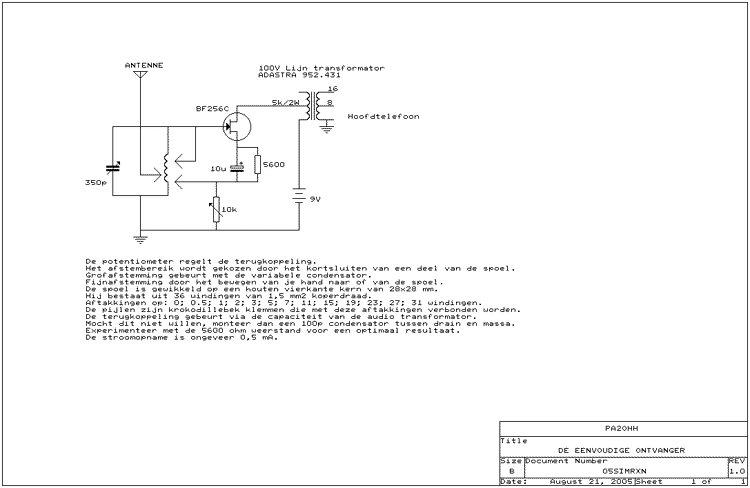
Schematic diagram of the simple receiver.
Sorry for the Dutch
text but you will understand it after reading this article.
big
diagram
Coarse tuning with the variable capacitor and fine tuning with your
hand
The various shortwave bands can be selected by shortening a part of
the coil from the top. Coarse tuning can be done with the variable capacitor.
There is a very simple solution for the fine tuning: Move your hand towards or
from the coil. With this fine tuning, it is possible to tune the whole 30 meter
band and also the CW or SSB part of the 40 meter band!
Automatic frequency correction
As you will understand, the
stability of the receiver is not so good because there is a direct coupling of
the oscillator with the antenna and the construction is very open without any
screening. But the fine tuning with your hand is also an automatic frequency
correction! You will move your hand automatically to correct for the frequency
drift.
The coil
The coil is wound with 1,5mm solid copper wire (black) on
a square strip of wood of 28x28 mm. The windings with a tap are pulled upwards a
little and the isolation is removed..The antenna, source of the fet and the
short from the top are connected to these taps with crocodile clips. The correct
tap is determined experimentally by ear. There is also a tap on zero windings.
This is located in the middle of the connection between the coil and the ground
of the tuning capacitor.
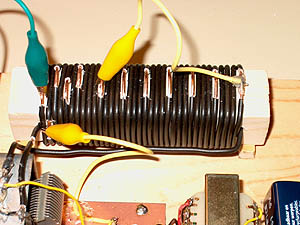
The coil in use for 20 meter.
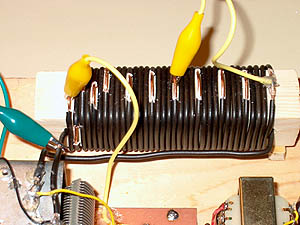
The coil in use for 40 meter.
In the evening, the antenna
is connected to tap 0 (a few cm from ground).
At tap 1 the receiver is
overloaded then by the strong signals.
WHAT CAN YOU HEAR WITH SUCH A SIMPLE RECEIVER
Below an impression about what you can receive. There is not really tried to receive as many stations as possible, so now and then I listened for a while to some QSO's.
| 80 METER, 15 AUGUST 2005, 1830 -
1939 GMT | |
| Listened the first half hour to the transmission of the club station of PI4AA. Excellent signal! The other stations are heard in the second half hour. | |
| 80 meter SSB: PI4AA (excellent, little interference) PE1NXK (zwak, no interference) PA2JWN (good, no interference) PA2AD (good, no interference) PA3ESU (good, no interference) PE1ABT (zwak, no interference) DL9HAM (excellent, little interference) |
80 meter CW: G0TMX (zeer good, no interference) F6EJN (zeer good, no interference) G3VRU (very good, little interference) SM5COP (very good, no interference) G3SES (good, no interference) G0SZR (good, no interference) OM3KAP (good, veel storing) G3SES (good, no interference) DJ4EL (good, little interference) |
| 40 METER, 23 AUGUST 2005, 1852 -
1954 GMT | |
| Also many long QSO's so that it was difficult to get the calls because they were not given very often or in a foreign languaged. | |
| 40 meter SSB: DH3RS (good, little interference) DL7HKL (very good, little interference) DL4MA (good, little interference) M0JED (very good, veel storing) ON4KPR (very good, little interference) M3DOQ (good, little interference) F6FJH (good, little interference) DC4DG (good, little interference) OK1BN (very good, veel storing) DF1WR (very good, little interference) OE6RLF (good, little interference) G0CBW (good, little interference) |
40 meter CW: DJ5MZ (very good, little interference) SM1OII (very good, little interference) IK1JJH (good, little interference) RL3AF (good, veel storing) DL7YAV (good, veel storing) HA3OD (good, little interference) DL8PG (very good, veel storing) UA9UFO (good, little interference) G3HNC (very good, little interference) PC7CW (good, little interference) DL0AU (good, veel storing) EA7GV (good, little interference) EA7CJN (good, little interference) DJ6ZM (very good, little interference) HA5BDM (good, little interference) RW3AA/P (good, little interference) DL4CH (good, little interference) |
| 30 METER, 16 AUGUST 2005, 1821 -
1900 GMT en 2014 - 2054 GMT | |
| There are no SSB stations on 30 meter. In CW, it is much easier to get the calls than in SSB as foreign languages are not a problem in CW. | |
| 30 meter SSB: No SSB stations on 30 meter |
30 meter CW: EU3DN (good, little interference) OE1ZL (good, little interference) G3JUX (zwak, little interference) OE5CSP (good, veel storing) ND9M/MM (good, little interference) OM8AG (very good, little interference) LA2U (good, little interference) S59AA (good, little interference) ONA10KC (good, little interference) S52VP (very good, no interference) SN25SOL (very good, no interference) IK2WXW (very good, no interference) SQ9I (good, little interference) LY2ER (very good, veel storing) DQ5M (good, little interference) YU1FE (very good, little interference) LY2PX (good, little interference) T94DO (good, veel storing) GM4KGK (good, little interference) M0NLD (zwak, little interference) IZ0FZQ (good, little interference) F5BPM (very good, little interference) JA4FHE (very good!, little interference) EA2PA (zwak, little interference) F5PRH (good, little interference) G3NQF (very good, little interference) OK2WK (good, little interference) IK0NOJ (good, little interference) UA3QXD (zwak, little interference) DL3KVR (very good, little interference) RZ3EA (good, little interference) |
| 20 METER, 19 AUGUST 2005, 1905 -
2009 GMT | |
| On 20 meter often short QSO's with the calls clearly spelled. | |
| 20 meter SSB: K4KAL (good, little interference) EA7HW (very good, little interference) RL3FT (very good, little interference) SV9GPV (good, little interference) OE4XRK (excellent, no interference) RK3XXA/P (very good, no interference) CN8SG (very good, little interference) S58AL (excellent, no interference) IS6BXV (good, little interference) US4IXQ (excellent, veel storing) ER4DX (excellent, veel storing) |
20 meter CW: K4EJQ (good, little interference) W2YJ (good, little interference) UT7LM (very good, little interference) W4PKU (very good, little interference) HA1KXX (very good, no interference) S8IDX (good, no interference) UA3TN (good, no interference) EA5BZJ (very good, little interference) RW6BD (good, little interference) YO4PP (good, no interference) IK1ATK (good, little interference) UA3AO (very good, little interference) US5FA (very good, little interference) YU1XI (very good, little interference) |
My frequency scale
The next table is used as a scale to tune to the
various bands.
The 5.3 MHz band is an amateurband that is used in the
UK.
The sensitivity on 15 meter is less good, the reason is not found
yet.
| Band | Antenna tap | Source tap | Top tap | Tune (degrees) |
Sensitivity |
| 80 | 3 (2.5wdg) | 4 (4.5wdg) | 12 (35wdg) | 270 | 4 uV |
| 80 | 1 (0.5wdg) | 3 (2.5wdg) | 12 (35wdg) | 270 | 8 uV |
| 5.3 MHz | 3 (2.5wdg) | 4 (4.5wdg) | 12 (35wdg) | 365 | 4 uV |
| 5.3 MHz | 2 (1.5wdg) | 4 (4.5wdg) | 12 (35wdg) | 365 | 4 uV |
| 40 | 1 (0.5wdg) | 2 (1.5wdg) | 8 (19wdg) | 350 | 4 uV |
| 40 | 0 (wire) | 1 (0.5wdg) | 8 (19wdg) | 350 | 16 uV |
| 30 | 1 (0.5wdg) | 2 (1.5wdg) | 6 (11wdg) | 355 | 4 uV |
| 20 | 1 (0.5wdg) | 2 (1.5wdg) | 6 (11wdg) | 360+95 | 4 uV |
| 17 | 1 (0.5wdg) | 2 (1.5wdg) | 5 (7wdg) | 360+90 | 4 uV |
| 15 | 0 (wire) | 1 (0.5wdg) | 5 (7wdg) | 360+130 | 8 uV |
| 12 | 0 (wire) | 1 (0.5wdg) | 4 (4.5wdg) | 360+120 | 4 uV |
| 10 | 0 (wire) | 1 (0.5wdg) | 4 (4.5wdg) | 360+170 | 4 uV |